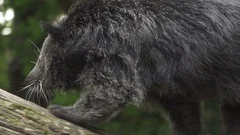Discounted video footage

The binturong (Arctictis binturong), also known as the bearcat, is a viverrid native to South and Southeast Asia. It is uncommon in much of its range, and has been assessed as Vulnerable on the IUCN Red List because of a declining population trend that is estimated at more than 30% since the mid 1980s. The binturong is the only living species in the genus Arctictis. Viverra binturong was the scientific name used by Thomas Stamford Raffles in 1822 for a binturong collected in Malacca. The scientific name of the genus Arctictis was coined by Coenraad Jacob Temminck in 1824. Arctictis is a monotypic taxon; its morphology is similar to that of members of the genera Paradoxurus and Paguma.The binturong is long and heavy, with short, stout legs. It has a thick coat of coarse black hair. The bushy and prehensile tail is thick at the root, gradually tapering, and curls inwards at the tip. The muzzle is short and pointed, somewhat turned up at the nose, and is covered with bristly hairs, brown at the points, which lengthen as they diverge, and form a peculiar radiated circle round the face. The eyes are large, black and prominent. The ears are short, rounded, edged with white, and terminated by tufts of black hair. There are six short rounded incisors in each jaw, two canines, which are long and sharp, and six molars on each side. The hair on the legs is short and of a yellowish tinge. The feet are five-toed, with large strong claws; the soles are bare, and applied to the ground throughout the whole of their length; the hind ones are longer than the fore ones.
